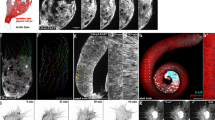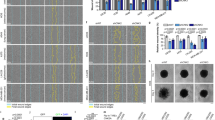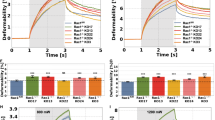Abstract
Actomyosin contractility is a mechanism by which cells exert locomotory force against their environment1. Signalling downstream of the small GTPase Rho increases contractility through Rho-kinase (ROCK)-mediated regulation of myosin-II light chain (MLC2) phosphorylation. Cdc42 signalling has been shown to control cell polarity2. Tumour cells can move through a three-dimensional matrix with either a rounded morphology3,4 characterized by Rho–ROCK dependence5 or with an elongated morphology3,4 characterized by Rho–ROCK independence5. Here we show that contractility necessary for elongated morphology and invasion can be generated by Cdc42–MRCK signalling. MRCK (myotonic dystrophy kinase-related Cdc42-binding kinase) cooperates with ROCK in the maintenance of elongated morphology and invasion and either MRCK or ROCK is sufficient for MLC2 phosphorylation, through the inhibitory phosphorylation of myosin phosphatase. By contrast, in rounded ROCK-dependent movement, where MLC2 phosphorylation is higher, MRCK has a smaller role. Our data show that a Cdc42–MRCK signal mediates myosin-dependent cell motility and highlight convergence between Rho and Cdc42 signalling.
This is a preview of subscription content, access via your institution
Access options
Subscribe to this journal
Receive 12 print issues and online access
$209.00 per year
only $17.42 per issue
Buy this article
- Purchase on Springer Link
- Instant access to full article PDF
Prices may be subject to local taxes which are calculated during checkout




Similar content being viewed by others
Accession codes
References
Lauffenburger, D. A. & Horwitz, A. F. Cell migration: a physically integrated molecular process. Cell 84, 359–369 (1996).
Raftopoulou, M. & Hall, A. Cell migration: Rho GTPases lead the way. Dev. Biol. 265, 23–32 (2004).
Wolf, K. et al. Compensation mechanism in tumor cell migration: mesenchymal-amoeboid transition after blocking of pericellular proteolysis. J. Cell Biol. 160, 267–277 (2003).
Friedl, P. & Wolf, K. Tumour-cell invasion and migration: diversity and escape mechanisms. Nature Rev. Cancer 3, 362–374 (2003).
Sahai, E. & Marshall, C. J. Differing modes of tumour cell invasion have distinct requirements for Rho/ROCK signalling and extracellular proteolysis. Nature Cell Biol. 5, 711–719 (2003).
Ishizaki, T. et al. The small GTP-binding protein Rho binds to and activates a 160 kDa Ser/Thr protein kinase homologous to myotonic dystrophy kinase. EMBO J. 15, 1885–1893 (1996).
Leung, T., Chen, X. Q., Manser, E. & Lim, L. The p160 RhoA-binding kinase ROK alpha is a member of a kinase family and is involved in the reorganization of the cytoskeleton. Mol. Cell. Biol. 16, 5313–5327 (1996).
Matsui, T. et al. Rho-associated kinase, a novel serine/threonine kinase, as a putative target for small GTP binding protein Rho. EMBO J. 15, 2208–2216 (1996).
Leung, T., Chen, X. Q., Tan, I., Manser, E. & Lim, L. Myotonic dystrophy kinase-related Cdc42-binding kinase acts as a Cdc42 effector in promoting cytoskeletal reorganization. Mol. Cell. Biol. 18, 130–140 (1998).
Amano, M. et al. Phosphorylation and activation of myosin by Rho-associated kinase (Rho-kinase). J. Biol. Chem. 271, 20246–20249 (1996).
Kimura, K. et al. Regulation of myosin phosphatase by Rho and Rho-associated kinase (Rho-kinase). Science 273, 245–248 (1996).
Tan, I., Ng, C. H., Lim, L. & Leung, T. Phosphorylation of a novel myosin binding subunit of protein phosphatase 1 reveals a conserved mechanism in the regulation of actin cytoskeleton. J. Biol. Chem. 276, 21209–21216 (2001).
Ikebe, M. & Hartshorne, D. J. Phosphorylation of smooth muscle myosin at two distinct sites by myosin light chain kinase. J. Biol. Chem. 260, 10027–10031 (1985).
Komatsu, S. & Ikebe, M. ZIP kinase is responsible for the phosphorylation of myosin II and necessary for cell motility in mammalian fibroblasts. J. Cell Biol. 165, 243–254 (2004).
Kawano, Y. et al. Phosphorylation of myosin-binding subunit (MBS) of myosin phosphatase by Rho-kinase in vivo. J. Cell Biol. 147, 1023–1038 (1999).
Feng, J. et al. Inhibitory phosphorylation site for Rho-associated kinase on smooth muscle myosin phosphatase. J. Biol. Chem. 274, 37385–37390 (1999).
Mills, J.C., Stone, N. L., Erhardt, J. & Pittman, R. N. Apoptotic membrane blebbing is regulated by myosin light chain phosphorylation. J. Cell Biol. 140, 627–636 (1998).
Straight, A. F. et al. Dissecting temporal and spatial control of cytokinesis with a myosin II inhibitor. Science 299, 1743–1747 (2003).
Friedl, P. & Brocker, E. B. Reconstructing leukocyte migration in 3D extracellular matrix by time-lapse videomicroscopy and computer-assisted tracking. Methods Mol. Biol. 239, 77–90 (2004).
Mukai, H. The structure and function of PKN, a protein kinase having a catalytic domain homologous to that of PKC. J. Biochem. (Tokyo) 133, 17–27 (2003).
Tan, I., Seow, K. T., Lim, L. & Leung, T. Intermolecular and intramolecular interactions regulate catalytic activity of myotonic dystrophy kinase-related Cdc42-binding kinase alpha. Mol. Cell. Biol. 21, 2767–2778 (2001).
Nakamura, N. et al. Phosphorylation of ERM proteins at filopodia induced by Cdc42. Genes Cells 5, 571–581 (2000).
Dong, J. M., Leung, T., Manser, E. & Lim, L. Cdc42 antagonizes inductive action of cAMP on cell shape, via effects of the myotonic dystrophy kinase-related Cdc42-binding kinase (MRCK) on myosin light chain phosphorylation. Eur. J. Cell Biol. 81, 231–242 (2002).
Ichikawa, K., Ito, M. & Hartshorne, D. J. Phosphorylation of the large subunit of myosin phosphatase and inhibition of phosphatase activity. J. Biol. Chem. 271, 4733–4740 (1996).
Kiosses, W. B., Daniels, R. H., Otey, C., Bokoch, G. M. & Schwartz, M. A. A role for p21-activated kinase in endothelial cell migration. J. Cell Biol. 147, 831–844 (1999).
Sells, M. A., Boyd, J. T. & Chernoff, J. p21-activated kinase 1 (Pak1) regulates cell motility in mammalian fibroblasts. J. Cell Biol. 145, 837–849 (1999).
Sanders, L. C., Matsumura, F., Bokoch, G. M. & de Lanerolle, P. Inhibition of myosin light chain kinase by p21-activated kinase. Science 283, 2083–2085 (1999).
De Wever, O. et al. Tenascin-C and SF/HGF produced by myofibroblasts in vitro provide convergent pro-invasive signals to human colon cancer cells through RhoA and Rac. FASEB J. 18, 1016–1018 (2004).
Itoh, K. et al. An essential part for Rho-associated kinase in the transcellular invasion of tumor cells. Nature Med. 5, 221–225 (1999).
Malliri, A. et al. The transcription factor AP-1 is required for EGF-induced activation of rho-like GTPases, cytoskeletal rearrangements, motility, and in vitro invasion of A431 cells. J. Cell Biol. 143, 1087–1099 (1998).
Acknowledgements
We thank T. Leung for generous gifts of reagents, A. Klippel for the gift of anti-PKN3 antiserum, C. MacKintosh for the gift of microcystin-LR, J. Metcalfe for peptide synthesis, and A. Hall, J. Rosenblatt and E. Sahai for helpful discussion. S.W. is funded by an Institute of Cancer Research studentship. C.J.M. is a Gibb Life Fellow of Cancer Research UK. Work in C.J.M.'s laboratory is supported by Cancer Research UK.
Author information
Authors and Affiliations
Corresponding author
Ethics declarations
Competing interests
The authors declare no competing financial interests.
Supplementary information
Rights and permissions
About this article
Cite this article
Wilkinson, S., Paterson, H. & Marshall, C. Cdc42–MRCK and Rho–ROCK signalling cooperate in myosin phosphorylation and cell invasion. Nat Cell Biol 7, 255–261 (2005). https://doi.org/10.1038/ncb1230
Received:
Accepted:
Published:
Issue Date:
DOI: https://doi.org/10.1038/ncb1230
This article is cited by
-
Breast stiffness, a risk factor for cancer and the role of radiology for diagnosis
Journal of Translational Medicine (2023)
-
Role of cytoskeleton-related proteins in the acrosome reaction of Eriocheir sinensis spermatozoa
BMC Genomic Data (2023)
-
OVOL2 impairs RHO GTPase signaling to restrain mitosis and aggressiveness of Anaplastic Thyroid Cancer
Journal of Experimental & Clinical Cancer Research (2022)
-
CircTUBGCP3 Contributes to the Malignant Progression of Rectal Cancer
Digestive Diseases and Sciences (2022)
-
Morphodynamics facilitate cancer cells to navigate 3D extracellular matrix
Scientific Reports (2021)



